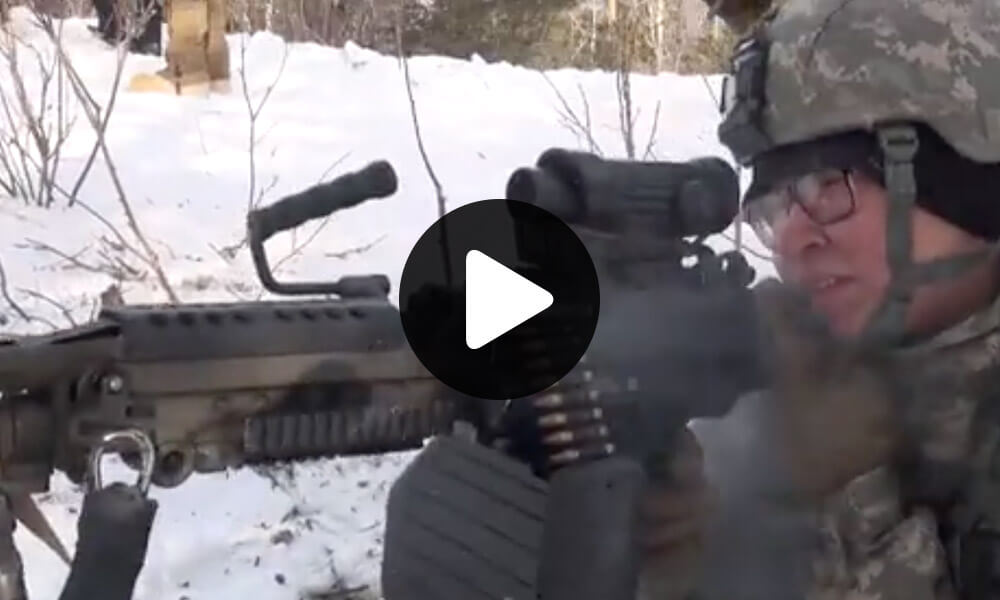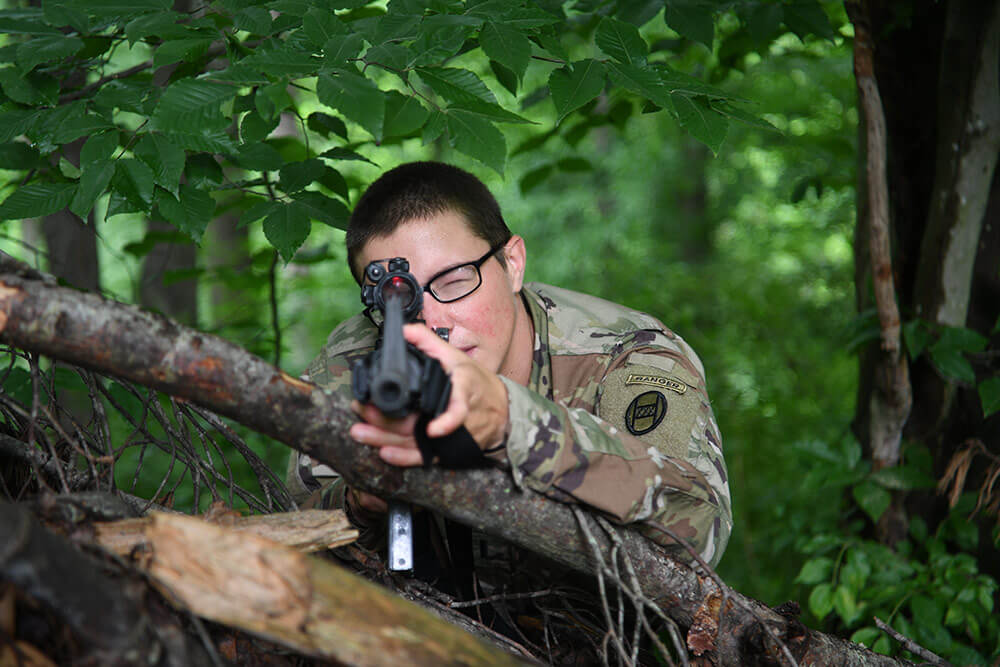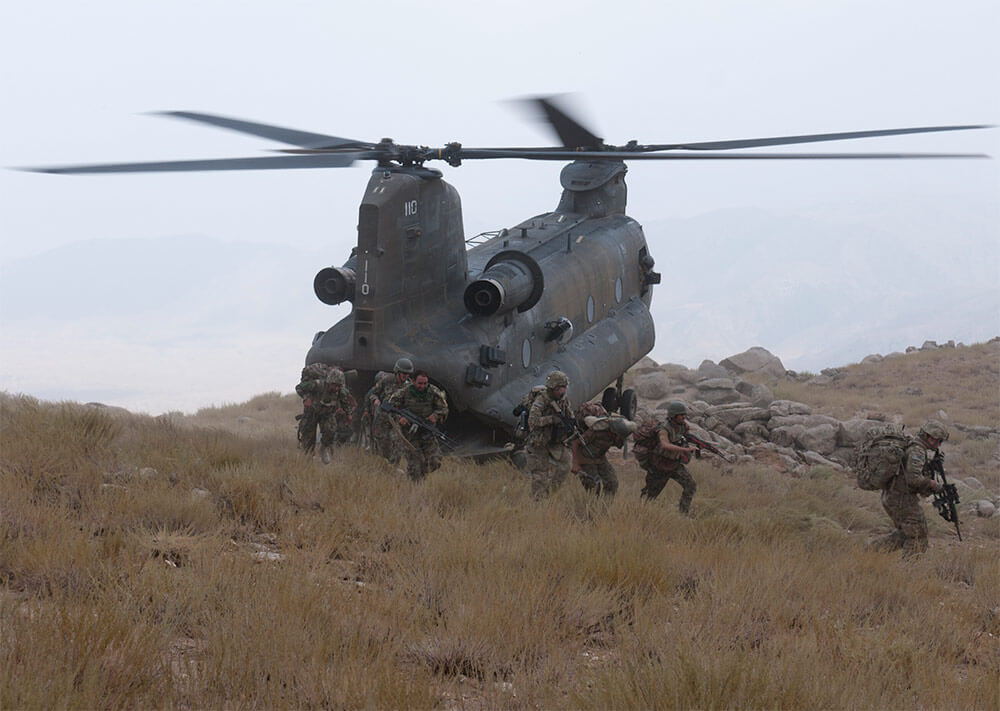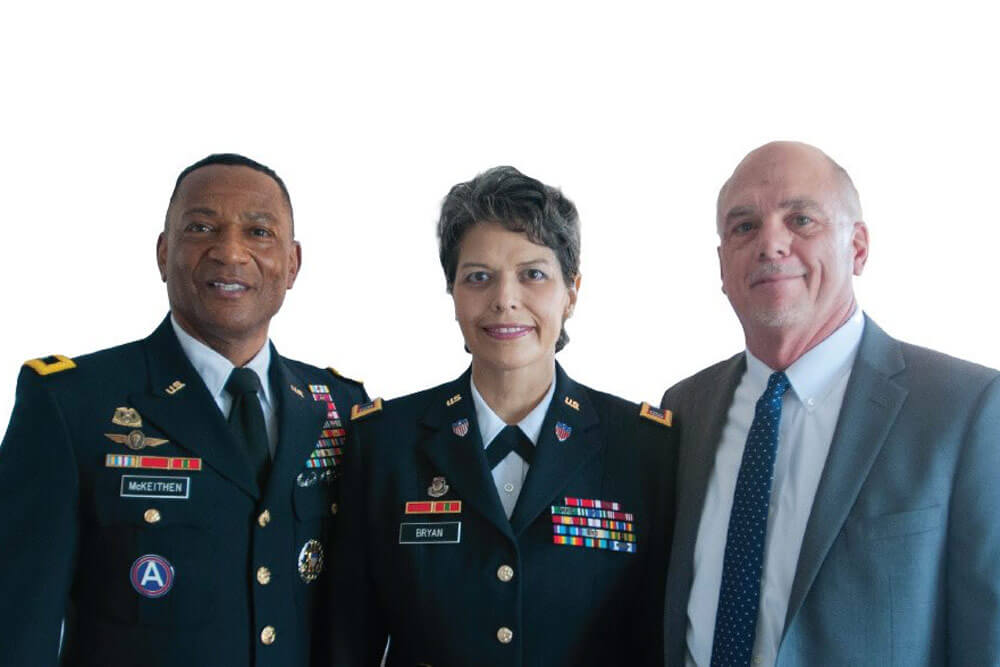Arctic Eagle 2018 Offers Austere Survival Training
Alaska Army National Guard SSG John Miller and his assault team ducked under branches and scampered up hills as they worked their way toward a tree line, from which they would be able to see the bunker they planned to assault. They communicated by hand signals. The only sound was snow crunching under boots and even that was faint.
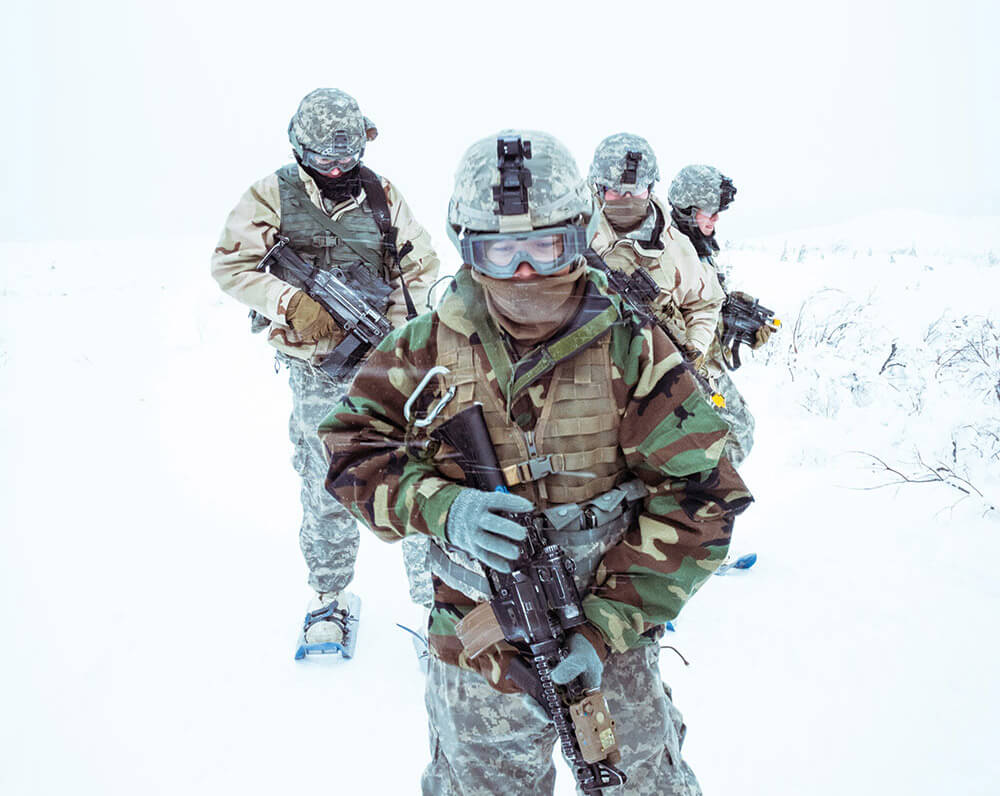
The assault team from Bravo Company 1st Battalion, 297th Infantry Regiment, followed in one another’s footsteps because that was easier than walking through the deep snow that covered the ground at Alaska’s Donnelly Training Area. It also hid their numbers as they continued the advance. To the assault team’s left, a support by fire team moved into position as the assault team reached the tree line. The support by fire team opened fire. Now the assault team assumed shooting positions. Two dropped to their knees, and two laid prone.
Shooting from the prone position was unusually difficult. The Soldiers laid on top of two feet of powdery snow, which made accurate shooting a challenge as the snow shifted under their weight. They could not stay down too long, because with the temperature rarely rising above 10 degrees Fahrenheit, staying dry was critical.
Welcome to Arctic Eagle 2018 – where the morale was high, the temperatures were low and the environment was rugged.
Hosted by the Alaska Army National Guard, and held Feb. 20 to March 8, Arctic Eagle is a Statewide exercise designed to train Soldiers on conducting sustained operations in austere, arctic conditions, said Exercise Planner Alaska Army National Guard MAJ Sean Pence.
Nature cooperated with providing the austere and arctic conditions – frigid temperatures, deep snowdrifts, icy winds and multiple snowstorms. Nonetheless, more than 1,100 Soldiers of National Guard forces from Alaska, Colorado, Connecticut, Indiana, Oregon, South Dakota, Utah, Vermont, Washington and Wyoming not only endured during the training, they thrived.
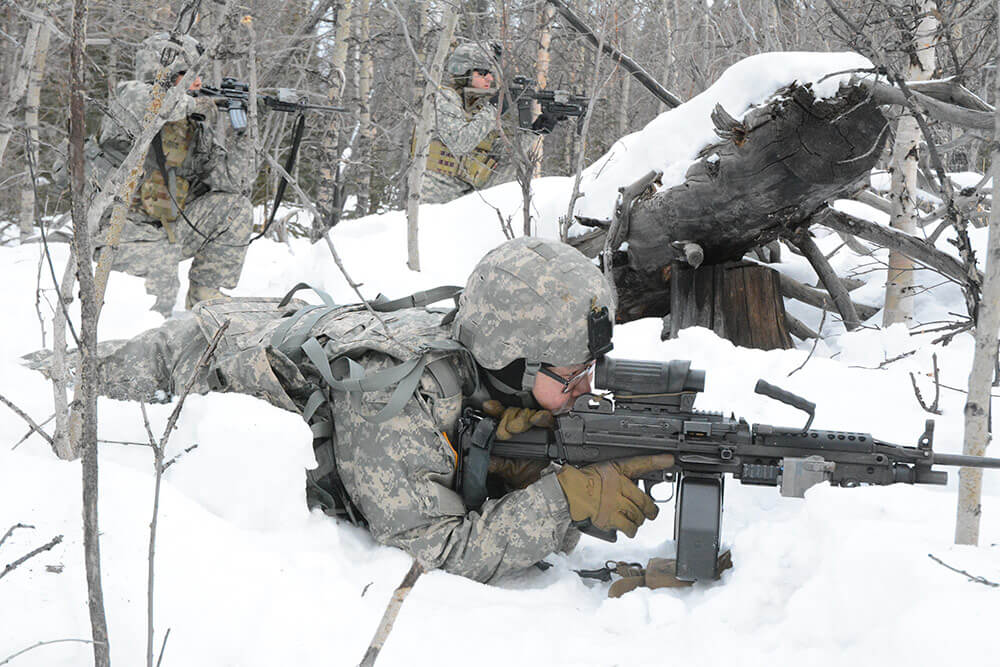
Also included in the event were active duty and Reserve Soldiers of U.S. Army Alaska, members of U.S. Coast Guard Alaska, personnel from the Environmental Protection Agency, staff from several Alaska State-level agencies and soldiers of the Canadian Armed Forces.
The two-week exercise consisted of scenario-based events at multiple locations, including Anchorage, Valdez, Ft. Greely at the Donnelly Training Area; Bethel, Kwethluk and Quinhagak in Western Alaska; along the Alaska-Canada border and areas north of Fairbanks near Murphy Dome. The scenarios included hazardous material detection and response, security and protection of critical infrastructure, triage, domain awareness patrol, communication and transportation support.
“Doing it in the cold will ideally make us that much better in regular temperatures,” said MAJ Pence.
With this concept in mind, the Soldiers of the 297th carried out their notional assault with precise attention to the details.
SSG Miller’s men fired on the bunker until the shift fire command was given, at which point the Soldiers turned their aim 15 degrees off target. That allowed SSG Miller to inch his way toward the bunker. SSG Miller threw in a grenade (the rounds were live; the grenade was not) and rolled away.

Later, the Soldiers gathered for a review. The cold-weather elements impacted everything about the assault – from getting in position, to aiming, to shooting. Everything, that is, except for the requirement of a quality execution. “Hey Support Fire,” SFC Matt Romine said. “You guys were lighting this thing up.”
He singled out PFC Zachary Tilton, praising him for hitting the bunker twice with 40 mm grenades. “You can be my grenadier any day of the week,” SFC Romine said. “That’s hard to do, and you did it twice.”
The standards of performance remain the same whether it is 20 below or a beautiful spring day. Though the circumstances were tough, that did not justify poor execution. “The temperature has nothing to do with the evaluation,” said CSM Cordell Gailliard, the Battalion Command Sergeant Major for Task Force Warhawg. CSM Gailliard flew in from Texas to evaluate Alaska’s 297th in advance of an upcoming deployment. “There are tasks we expect them to accomplish. There’s no change because of the temperature or the weather.”
PFC Tilton’s shot was unusually difficult because his stance (one foot on an uneven, snowy hill), breathing (labored for the cold) and even his hands (sheathed in gloves to protect his skin) were atypical to a normal training environment. PFC Tilton said he had a tough time figuring out how far away the target was because the snow washed out points of reference. He estimated 100 to 150 meters, fired his first grenade at 100 and adjusted when that came up short.
This all illustrates the dual goal of Arctic Eagle: train on how to execute proper technique and how to do so in arctic conditions. Permeating throughout the event was the sense that if Soldiers could succeed at Arctic Eagle, they could succeed in any normal conditions. And make no mistake, there were no “normal” conditions at Arctic Eagle. That is, unless it is considered normal to trek through two feet of snow wearing snowshoes and 40‑plus pounds of tactical gear.
No one can better attest to lack of normalcy than SPC Fabian Nietert, Charlie Company, 1st Battalion, 297th Infantry Regiment, Wyoming Army National Guard, who crept along an uphill sloping field one day during the second week of the training. He and the rest of his unit were assaulting a fictional enemy positioned at the top of the hill. Set up in a wedge formation, the Soldiers bounded forward.
As they neared the halfway point of the hill, SPC Nietert noticed that he and the Soldier to his right had gotten too close to each other. He needed a distance of three to five meters between them to limit the damage an enemy grenade could potentially do to them.
On a normal day, the adjustment would have been easy. SPC Nietert would just take a few steps to his left. But with a winter’s worth of snow on the ground, one step in the wrong place could have resulted in a chilling face plant that, in a real-world situation, would have put the specialist and the rest of his squad in danger.
SPC Nietert faced a decision that would speak volumes. If he moved left – the correct call – he would have to climb a steep embankment piled high with undisturbed snow. If he kept going straight – the wrong call – the path was beaten down, therefore making it easier to walk. This highlighted a reality that is a fact of any Army mission, but is intensified in extreme conditions like those at Arctic Eagle. That reality being, the challenges faced during training and in real-world situations are as much mental as they are physical. Can Soldiers make the right decisions when circumstances encouraged them to make wrong ones? Can they think clearly and execute successfully through the fog of cold, or any other extreme environment? The job of every Soldier is to be able to say yes to all of the above.
SPC Nietert turned left, up the hill because he was willing to take the tough route for the right reason instead of the easy route for the wrong reason. And it was tough. His first step put him in snow almost up to his knee. So did his second. He powered through. A few steps later, he “post-holed”– stepped into snow all the way past his knee. He started to pitch forward, and at the last second caught himself on a tree. “My legs were burning pretty bad,” he said.
SGT Cole Christensen, the squad leader, noticed SPC Nietert’s struggles. Like a quarterback aligning his backfield, SGT Christensen used hand signals to stop the unit and realign the formation. They recovered to successfully complete the mission. “Eventually you just smile,” SPC Nietert said. “It can’t get any worse. You can only go up from there. A sense of humor is what gets you through all this.”
Every Soldier at this extreme arctic exercise knew, above all, to keep one thing in mind – that the cold was a foe to be beaten, not a cause for complaint. “The cold is your number one adversary because it will kill you just as fast as the [actual] enemy,” said Alaska Army National Guard SGM Rob Whiteley.
The possible medical complications were myriad and serious. Alaska Army National Guard CPT Andrew Gray, the physician’s assistant for Alaska’s 297th, said the keys to staying healthy in an arctic environment are staying hydrated, wearing boots that fit well and avoiding sweating – not an easy task given the level of exertion put forth by the Soldiers each day. In warmer climates, allowing sweat to dry on your body would not be given a second thought. In arctic climates, sweat does not dry – it freezes. Allowing sweat to freeze on the body can lead to hypothermia – a deadly condition that occurs when body temperature falls below 95 degrees Fahrenheit. Arctic Eagle encompassed elements of survival training such as preventing cold weather injuries, constructing improvised shelters and evacuating a hypothermic casualty.
The icy weather had to be taken into consideration even when planning meal rations. Given the conditions, regular MREs would have frozen beyond salvation. Extreme cold weather MREs were served instead. They drew raves because, not only do they have more calories than regular MREs, according to Soldiers they taste better as well.
Paying attention to small details was crucial in Arctic Eagle. As Warrant Officer Keith Shannon of the 39th Canadian Brigade Group put it, “You better take care of yourself and your equipment or you’re going to get really cold, really fast.”
Situational awareness – always important – was magnified. Something as simple as picking up a weapon is generally routine. Right? Not during Arctic Eagle. Grabbing an M4 barehanded when it is 20 degrees below zero will instantly lead to contact frost burn and could rip the skin off of a Soldier’s palm.
Cold makes batteries die faster, communications systems fail and simple conversation difficult. Soldiers had to find ways to mitigate those issues. For example, some vehicles were left running at all times, because turning them off left open the possibility that the battery might die. That meant each vehicle burned more gas, but that was a small price to pay compared to risking Soldiers being left stranded.
That’s why Alaska Army National Guard SPC Zack Verfaillie waited one afternoon in his running HMMWV for a mounted crew gunnery exercise. SPC Verfaillie said the HMMWVs handled well on the snow and ice, which was a good thing because snow and ice were all the HMMWVs had to drive on at this training. Not a single inch of bare pavement was visible on the course – or for miles in any direction, for that matter. Despite the treacherous road conditions, riding in the HMMWV with SPC Verfaillie driving felt like riding in an SUV – that is, an SUV with an MK 19 mounted on top and a sharpshooting specialist named Kim Delgado firing it.
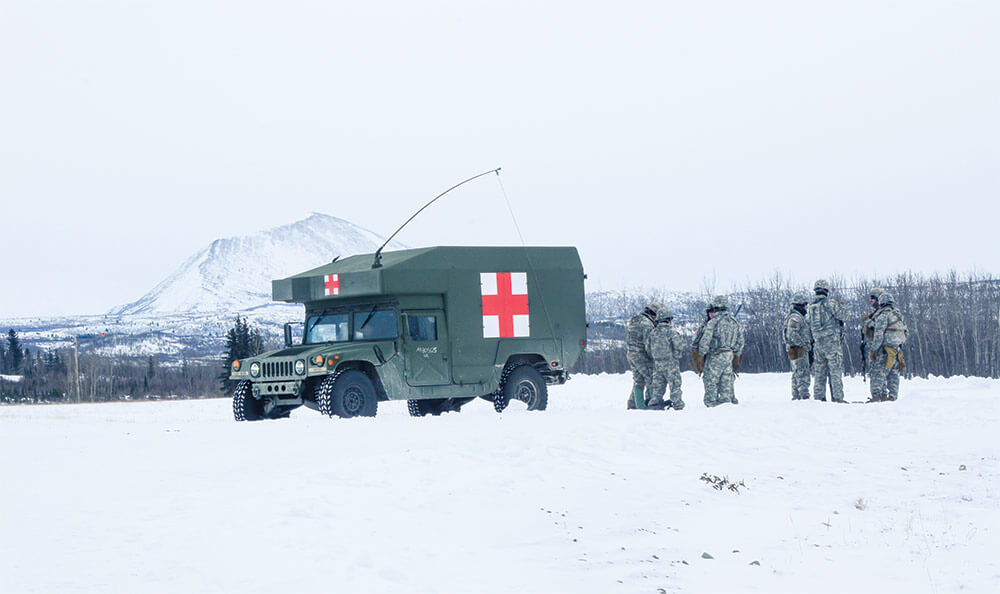
2LT Trent Bishop, the truck commander, scanned the horizon. “Target, tank, 12 o’clock, 100 meters,” he said into his radio. “Fire and adjust.”
From the turret, SPC Delgado spun the MK 19. Snow covered everything and had washed out visual cues that would have helped gauge the distance. Not a problem – SPC Delgado had learned to adapt. He studied the mounds between his position and the target. He read the almost imperceptible shadows they cast, and then…
Five 40 mm training grenades whistled toward the target.
He adjusted his aim and fired again. “Good hits, good hits,” 2LT Bishop said.
One day during Arctic Eagle, the temperature was 37 degrees below zero Fahrenheit. CPT Gray said Soldiers needed to keep a close eye on one another for signs of frost bite, exposure and exhaustion. On this day, Soldiers had the challenge of finding the line between being tough and being smart – between enduring the cold to get the mission done and occasionally ducking into the tent to get warm.
One night, Soldiers from Wyoming huddled in their 10-man squad tent around a burning stove, trying to keep warm. It was their fifth night sleeping in the tent. The stove worked well. Perhaps it worked too well, as soon two inches of standing water inside the tent resulted from the melting of the snow and ice on the ground. They had to fix that problem, and quickly. Could these Soldiers exhibit critical thinking and problem-solving skills under duress?
SGT Taylor Tobar came up with an idea. They would use their e-tools to dig trenches, and the water would drain out through them. The Soldiers quickly got to work, and the water seeped out within minutes.
The next day, the Soldiers in every other tent in Charlie Company stole the idea. As some Soldiers dug trenches, others hiked to the surrounding woods to cut branches to lay on the ground. The branches absorbed moisture, insulated the tents and provided cushion against the rock-hard ice.
SSG Donald Larkin and SGT Nick Haller arrived pulling an Ahkio sled overflowing with branches. They never got the chance to unload, as seemingly the entire unit made a surprise attack to pilfer the branches – tackling and wrestling each other, trying to escape with the desperately needed contraband.
Like SPC Nietert smiling through his post-holing, the Soldiers ignored the difficult circumstances to get the most out of a truly unique training opportunity. They kept a sense of humor and had a little fun in the process.
By Staff Writer Matthew Crossman
National Guard Bureau photos by Lauren di Scipio
